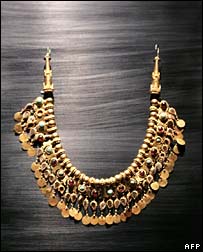Afghan
golden treasure on display By Lawrence Pollard
BBC News, Paris
There
is one darkened corridor in the Musee Guimet which will take your
breath away, as it winks at you with a glittering light.
This
exhibition is not only about gold - there is also fabulous Indian-looking
ivory and Egyptian glass.
But
the gold cannot help stealing the show.
This
is the treasure of Tilya Tepe, the Hill of Gold, from near the
Oxus river in northern Afghanistan - and it has quite a story
to tell.
Looting
Called
the Bactrian Gold, after the area at the crossroads of the trade
routes between China, India and the Mediterranean, it was unearthed
in 1978 by a Russian team.

They
had found the graves of nomadic aristocrats who died about the
time of the birth of Christ. More than 20,000 individual gold
items - from tiny beads and hearts sewn onto costume, to the shimmering
golden crown of a queen. Even golden sandals.
That was 1978. Soon after, more waves of invasion and conflict
led Afghanistan to chaos and civil war. As far as the outside
world knew, the treasure just disappeared. Had it been taken to
Moscow, or smuggled, or melted down?
The
national museum in Kabul was first looted by mujahadeen, then
vandalised by the Taleban.
As
the chaos intensified in the late 1990s, tribal factions and then
the Taleban attacked a vault in the grounds of the presidential
palace in Kabul, trying to find the treasure they suspected was
inside, but the inner doors stood firm.
Just
a handful of people knew what was there - and finally, in 2004,
the gold was uncovered, hidden in modest crates under piles of
old currency.
And
then the clamour began from international museums to take it on
tour. Americans, Dutch, Austrians, Koreans - all were overtaken
by French President Jacques Chirac, whose direct dealing with
Afghan President Hamid Karzai won the prize for France.
And
so it is now at the Musee Guimet, in Paris.
France
has a long history of archaeological work in Afghanistan, and
the show is a diplomatic coup. But more importantly, it is a treat.
Changing
perceptions
Much
of the jewellery in the Bactrian treasure is displayed on slender
poles. As you walk in front, they gently shake and shine, and
the crown, hung with dozens of tiny golden flakes, shivers like
wheat in a breeze.
It is
hoped the spectacle could go some way to altering perceptions of
Afghanistan in the outside world - that it's not just about camels
and Kalashnikovs, it's about a fabulous mix of cultures and has
a genuinely significant heritage.
For
me, that worked completely.
And
the real pleasure is that you do not need an expert's eye to spot
the influences. There are column capitals from Ai-Khanoum - a
Greek city in northern Afghanistan - which anyone can tell look
as if they are from a Greek temple.
There
are ivory tablets and sculptures of wide-hipped and large-breasted
dancing girls, which you know look Indian. A coin bears the Buddhist
wheel, one buckle bears Roman dolphins, another a Chinese-looking
devil... and on it goes.
Among
all the glitter and the simple thrill of seeing such beautiful
objects, there are also some sobering thoughts. One is that for
nearly a quarter of a century, Afghanistan's culture has been
systematically looted by illegal digging.
Ai-Khanoum
has been stripped. If there is other stuff as gorgeous as the
Bactrian gold, it may already have been stolen and smuggled.
Proceeds
When
it returns from its brief tour (which looks like taking in Holland,
Germany and the US), Afghanistan's golden treasure cannot be shown
to the Afghans for security reasons. They have never seen it,
and they will not now.
What
is desperately needed is money to pay for education, protection
of sites and security to stop smuggling - money which could be
raised by the tour of the treasures.
Normally,
a show of this magnitude would warrant a payment by the receiving
museum of hundreds of thousands, even into $1m-dollar territory.
The
Guimet, which helped organise the show, is giving one euro ($1.30)
per each ticket sold. If the show's a success, they can expect
to sell 50-100,000 tickets - which is a lot less than a million.
Even
if it is not enough, its something. So, for many reasons - if
you can - go to Paris.
Pay
your extra euro.
Goggle
at the Dazzle, and thank your lucky stars you've had the privilege
of seeing what the Afghans themselves can not see.